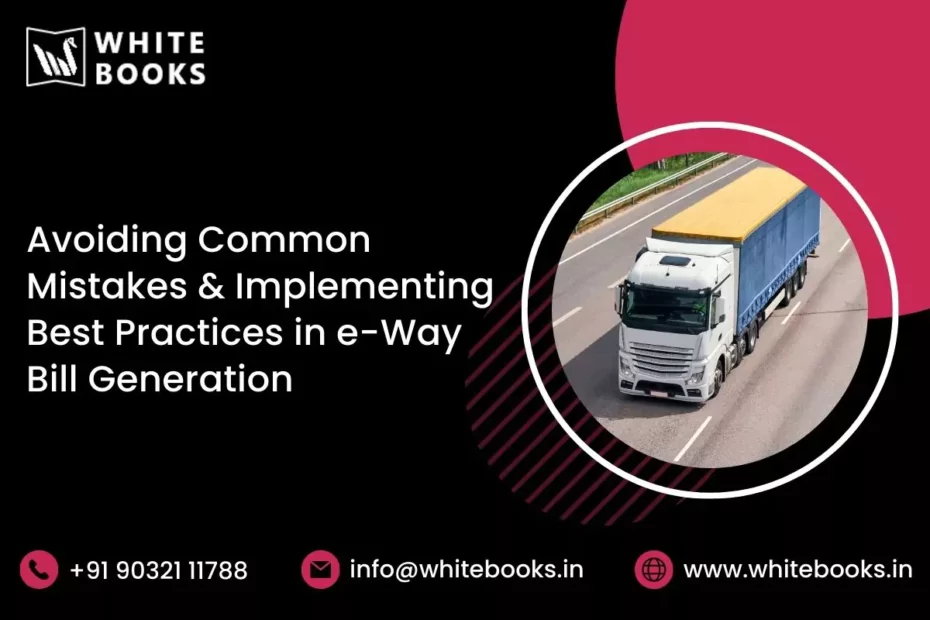Table of Contents
1. 5 Common Mistakes in e-Way Bill Generation for Seamless Logistics
When generating e-Way Bills, taxpayers and transporters often need to catch up due to the rush for quick processing. These errors can result in e-Way Bills being canceled by the taxpayer or rejected by the receiving party. To ensure a smooth process, it’s important to avoid the following common mistakes:
1.1. Incorrect Tax Values:
One common mistake is entering higher “Total Tax Values” for SGST, CGST, IGST, and Cess compared to the product’s actual “Value/Taxable Value.” Ensuring that the tax values accurately correspond to the product’s value is crucial.
1.2. Abnormal Value Entry:
Some users mistakenly enter an abnormal value exceeding ₹10.00 crores in the “Value/Taxable Value” field. It’s important to enter the correct value within the appropriate range to avoid inaccuracies and potential discrepancies.
1.3. Incorrect GSTIN:
Inaccurately entering the GSTIN of the counterparty is another common error. Double-checking and providing the correct GSTIN is essential to prevent complications in the e-Way Bill process.
1.4. Incorrect PIN Codes:
Mistakenly entering incorrect PIN Codes is a frequent mistake that can cause delays or issues during transportation. Providing accurate PIN Codes is crucial to ensure the seamless movement of goods.
1.5. Wrong HSN Codes:
HSN codes are essential for correctly classifying products for tax purposes. Errors in HSN code entry can lead to incorrect tax calculations and compliance issues. It’s important to verify and input the valid HSN codes for transported goods.
By being aware of these common mistakes and taking the necessary precautions during e-Way Bill generation, taxpayers and transporters can avoid cancellations, rejections, and potential complications in their logistics operations.
2. Best Practices for Accurate e-Way Bill Generation
2.1. Maintain Clients/Customers and Suppliers Master:
- Utilize the master menu feature in the e-Way Bill system to create a comprehensive master record of customers and suppliers.
- Enter their GSTIN (Goods and Services Tax Identification Number) for an easy population of details during e-Way Bill generation.
- This helps minimize errors related to GSTIN, place, state, and PIN codes.
2.2. Create a Products Master:
- Establish a product master within the e-Way Bill system by entering accurate and complete product details such as name, HSN (Harmonized System of Nomenclature) code, and tax rate.
- This enables the system to auto-populate product details by simply typing a few characters of the product name.
- Doing so can significantly reduce mistakes in HSN codes, tax rates, and unit quantity codes (UQC).
2.3. Verify Before Submission:
- Before submitting an e-Way Bill, it is crucial to cross-check all entered parameters to ensure accuracy and avoid errors.
- Review values and ensure they align with the actual transaction details.
- Verifying the information before submission can prevent inaccuracies and potential mistakes.
2.4. Manage Sub-Users Carefully:
- If multiple individuals or additional locations generate e-Way Bills, it is advisable to create sub-user accounts with assigned roles and responsibilities.
- Exercise caution when creating these accounts and promptly update passwords or freeze accounts in case of personnel changes to prevent misuse and maintain data security.
2.5. Register for Other Facilities with Care:
- When using SMS-based or Android-based e-Way Bill management, it is important to be cautious and pay attention to avoid errors during parameter typing.
- When registering as a transporter, ensure a thorough understanding of the responsibilities and obligations of generating e-Way Bills for other parties.
- By being diligent and attentive during these processes, errors can be minimized, and the smooth flow of goods can be ensured.
6. API Interface for Large Taxpayers/Transporters:
- For entities generating a large volume of e-Way Bills, utilizing an API (Application Programming Interface) interface is recommended.l
- This involves site-to-site integration between the taxpayer’s and e-Way Bill systems, enabling direct requests for e-Way Bill numbers during invoice generation.
- Implementing an API interface eliminates duplicate data entry and significantly reduces errors.
- However, access to this facility is subject to government-defined criteria, and a formal request to the department is required.
By implementing these best practices, taxpayers and operators can enhance the accuracy of e-Way Bill generation, reduce mistakes, and ensure compliance with regulations, ultimately leading to smoother logistics operations.
